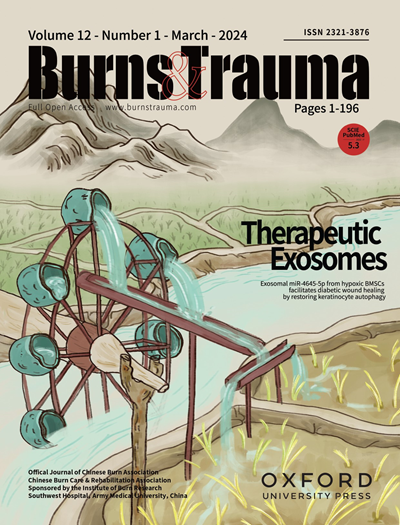Histone deacetylase 3-specific inhibitor RGFP966 attenuates oxidative stress and inflammation after traumatic brain injury by activating the Nrf2 pathway
IF 6.3
1区 医学
Q1 DERMATOLOGY
引用次数: 0
Abstract
Background Oxidative stress (OS) and inflammatory reactions play pivotal roles in secondary brain injury after traumatic brain injury (TBI). Histone deacetylase 3 (HDAC3) controls the acetylation of histones and non-histones, which has a significant impact on the central nervous system’s reaction to damage. This research determined the implications of RGFP966, a new and specific inhibitor of HDAC3, for the antioxidant (AO) systems mediated by nuclear factor erythroid2-related factor 2 (Nrf2) and the Nod-like receptor protein 3 (NLRP3) inflammasome in TBI. The study also studied the underlying mechanisms of RGFP966’s actions. Our objective was to examine the impacts and underlying RGFP966 mechanisms in TBI. Methods In vitro, a rat cortical neuron OS model was induced by H2O2, followed by the addition of RGFP966 to the culture medium. Neurons were collected after 24 h for western blot (WB), terminal deoxynucleotidyl transferase dUTP nick end labeling (TUNEL) and 2′-7′-dichlorodihydrofluorescein diacetate staining. In vivo, RGFP966 (10 mg/kg) was administered post-TBI. Brain tissue water content and modified neurological severity scores were assessed 72 h post-injury. Cortical tissues surrounding the focal injury were subjected to western blot, TUNEL staining, Nissl staining and immunofluorescence/immunohistochemistry staining, and malondialdehyde level, hindered glutathione content and superoxide dismutase activity were measured. Serum was collected for the enzyme-linked immunosorbent assay. Nrf2-specific shRNA lentivirus was injected into the lateral ventricle of rats for 7 days, and cerebral cortex tissue was analyzed by WB and real-time polymerase chain reaction. Results During in vitro and in vivo experiments, RGFP966 suppressed HDAC3 expression, promoted Nrf2 nuclear translocation, activated downstream AO enzymes, mitigated excessive reactive oxygen species production and alleviated nerve cell apoptosis. RGFP966 effectively reduced brain edema and histological damage and enhanced neurological and cognitive function in rats with TBI. RGFP966 markedly inhibited NLRP3 inflammasome activation mediated by high-mobility group box 1 (HMGB1)/toll-like receptor 4 (TLR4). Nrf2 knockdown in TBI rats attenuated the AO and anti-inflammatory, neuroprotective impacts of RGFP966. Conclusions Overall, our findings demonstrate that RGFP966 can mitigate the first brain damage and neurological impairments in TBI. The underlying mechanism involves triggering the Nrf2-mediated AO system and negatively regulating the HMGB1/TLR4-mediated NLRP3 inflammasome pathway.组蛋白去乙酰化酶 3 特异性抑制剂 RGFP966 通过激活 Nrf2 通路减轻脑外伤后的氧化应激和炎症反应
背景 氧化应激(OS)和炎症反应在创伤性脑损伤(TBI)后的继发性脑损伤中起着关键作用。组蛋白去乙酰化酶 3(HDAC3)控制着组蛋白和非组蛋白的乙酰化,对中枢神经系统对损伤的反应有重要影响。这项研究确定了 HDAC3 的新型特异性抑制剂 RGFP966 对创伤性脑损伤中由核因子红细胞相关因子 2(Nrf2)和类 Nod 受体蛋白 3(NLRP3)炎性体介导的抗氧化(AO)系统的影响。该研究还对 RGFP966 作用的潜在机制进行了研究。我们的目标是研究 RGFP966 在创伤性脑损伤中的影响和潜在机制。方法 在体外,用 H2O2 诱导大鼠皮质神经元 OS 模型,然后在培养基中加入 RGFP966。24 h后收集神经元进行Western blot(WB)、末端脱氧核苷酸转移酶DUTP缺口标记(TUNEL)和2′-7′-二氯二氢荧光素二乙酸酯染色。在体内,创伤后给药 RGFP966(10 毫克/千克)。伤后 72 小时评估脑组织含水量和改良神经系统严重程度评分。对病灶损伤周围的皮质组织进行 Western 印迹、TUNEL 染色、Nissl 染色和免疫荧光/免疫组化染色,并测定丙二醛水平、谷胱甘肽含量和超氧化物歧化酶活性。收集血清进行酶联免疫吸附试验。向大鼠侧脑室注射特异性 Nrf2 shRNA 慢病毒 7 天,用 WB 和实时聚合酶链反应分析大脑皮层组织。结果 在体外和体内实验中,RGFP966抑制了HDAC3的表达,促进了Nrf2的核转位,激活了下游AO酶,缓解了活性氧的过度生成,减轻了神经细胞凋亡。RGFP966 能有效减轻创伤性脑损伤大鼠的脑水肿和组织学损伤,增强其神经和认知功能。RGFP966 能显著抑制由高迁移率基团框 1(HMGB1)/类鹦鹉螺受体 4(TLR4)介导的 NLRP3 炎性体的激活。在 TBI 大鼠体内敲除 Nrf2 会减弱 RGFP966 对 AO 和抗炎及神经保护的影响。结论 总体而言,我们的研究结果表明,RGFP966 可减轻 TBI 首次脑损伤和神经损伤。其基本机制包括触发 Nrf2 介导的 AO 系统和负向调节 HMGB1/TLR4 介导的 NLRP3 炎性体通路。
本文章由计算机程序翻译,如有差异,请以英文原文为准。
求助全文
约1分钟内获得全文
求助全文
来源期刊

Burns & Trauma
医学-皮肤病学
CiteScore
8.40
自引率
9.40%
发文量
186
审稿时长
6 weeks
期刊介绍:
The first open access journal in the field of burns and trauma injury in the Asia-Pacific region, Burns & Trauma publishes the latest developments in basic, clinical and translational research in the field. With a special focus on prevention, clinical treatment and basic research, the journal welcomes submissions in various aspects of biomaterials, tissue engineering, stem cells, critical care, immunobiology, skin transplantation, and the prevention and regeneration of burns and trauma injuries. With an expert Editorial Board and a team of dedicated scientific editors, the journal enjoys a large readership and is supported by Southwest Hospital, which covers authors'' article processing charges.
 求助内容:
求助内容: 应助结果提醒方式:
应助结果提醒方式:


